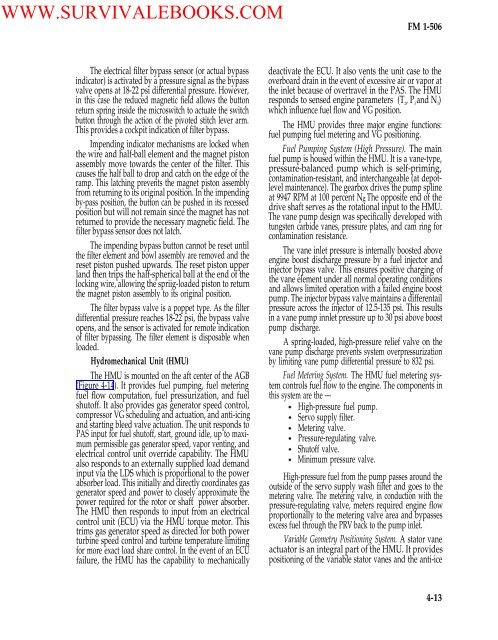FM 1-506 Fundamentals of Aircraft Power Plants ... - Survival Books
FM 1-506 Fundamentals of Aircraft Power Plants ... - Survival Books
FM 1-506 Fundamentals of Aircraft Power Plants ... - Survival Books
Create successful ePaper yourself
Turn your PDF publications into a flip-book with our unique Google optimized e-Paper software.
WWW.SURVIVALEBOOKS.COM<strong>FM</strong> 1-<strong>506</strong>The electrical filter bypass sensor (or actual bypassindicator) is activated by a pressure signal as the bypassvalve opens at 18-22 psi differential pressure. However,in this case the reduced magnetic field allows the buttonreturn spring inside the microswitch to actuate the switchbutton through the action <strong>of</strong> the pivoted stitch lever arm.This provides a cockpit indication <strong>of</strong> filter bypass.Impending indicator mechanisms are locked whenthe wire and half-ball element and the magnet pistonassembly move towards the center <strong>of</strong> the filter. Thiscauses the half ball to drop and catch on the edge <strong>of</strong> theramp. This latching prevents the magnet piston assemblyfrom returning to its original position. In the impendingby-pass position, the button can be pushed in its recessedposition but will not remain since the magnet has notreturned to provide the necessary magnetic field. Thefilter bypass sensor does not latch.The impending bypass button cannot be reset untilthe filter element and bowl assembly are removed and thereset piston pushed upwards. The reset piston upperland then trips the half-spherical ball at the end <strong>of</strong> thelocking wire, allowing the spriig-loaded piston to returnthe magnet piston assembly to its original position.The filter bypass valve is a poppet type. As the filterdifferential pressure reaches 18-22 psi, the bypass valveopens, and the sensor is activated for remote indication<strong>of</strong> filter bypassing. The filter element is disposable whenloaded.Hydromechanical Unit (HMU)The HMU is mounted on the aft center <strong>of</strong> the AGB(Figure 4-14). It provides fuel pumping, fuel meteringfuel flow computation, fuel pressurization, and fuelshut<strong>of</strong>f. It also provides gas generator speed control,compressor VG scheduling and actuation, and anti-icingand starting bleed valve actuation. The unit responds toPAS input for fuel shut<strong>of</strong>f, start, ground idle, up to maximumpermissible gas generator speed, vapor venting, andelectrical control unit override capability. The HMUalso responds to an externally supplied load demandinput via the LDS which is proportional to the powerabsorber load. This initially and directly coordinates gasgenerator speed and power to closely approximate thepower required for the rotor or shaft power absorber.The HMU then responds to input from an electricalcontrol unit (ECU) via the HMU torque motor. Thistrims gas generator speed as directed for both powerturbine speed control and turbine temperature limitingfor more exact load share control. In the event <strong>of</strong> an ECUfailure, the HMU has the capability to mechanicallydeactivate the ECU. It also vents the unit case to theoverboard drain in the event <strong>of</strong> excessive air or vapor atthe inlet because <strong>of</strong> overtravel in the PAS. The HMUresponds to sensed engine parameters (T 2, P 3and N 3)which influence fuel flow and VG position.The HMU provides three major engine functions:fuel pumping fuel metering and VG positioning.Fuel Pumping System (High Pressure). The mainfuel pump is housed within the HMU. It is a vane-type,pressure-balanced pump which is self-priming,contamination-resistant, and interchangeable (at depotlevelmaintenance). The gearbox drives the pump splineat 9947 RPM at 100 percent Ng The opposite end <strong>of</strong> thedrive shaft serves as the rotational input to the HMU.The vane pump design was specifically developed withtungsten carbide vanes, pressure plates, and cam ring forcontamination resistance.The vane inlet pressure is internally boosted aboveengine boost discharge pressure by a fuel injector andinjector bypass valve. This ensures positive charging <strong>of</strong>the vane element under all normal operating conditionsand allows limited operation with a failed engine boostpump. The injector bypass valve maintains a differentailpressure across the injector <strong>of</strong> 12.5-135 psi. This resultsin a vane pump innlet pressure up to 30 psi above boostpump discharge.A spring-loaded, high-pressure relief valve on thevane pump discharge prevents system overpressurizationby limiting vane pump differential pressure to 832 psi.Fuel Metering System. The HMU fuel metering systemcontrols fuel flow to the engine. The components inthis system are the —High-pressure fuel pump.Servo supply filter.Metering valve.Pressure-regulating valve.Shut<strong>of</strong>f valve.Minimum pressure valve.High-pressure fuel from the pump passes around theoutside <strong>of</strong> the servo supply wash filter and goes to themetering valve. The metering valve, in conduction with thepressure-regulating valve, meters required engine flowproportionally to the metering valve area and bypassesexcess fuel through the PRV back to the pump inlet.Variable Geometry Positioning System. A stator vaneactuator is an integral part <strong>of</strong> the HMU. It providespositioning <strong>of</strong> the variable stator vanes and the anti-ice4-13
















